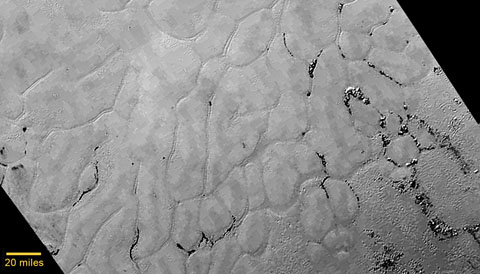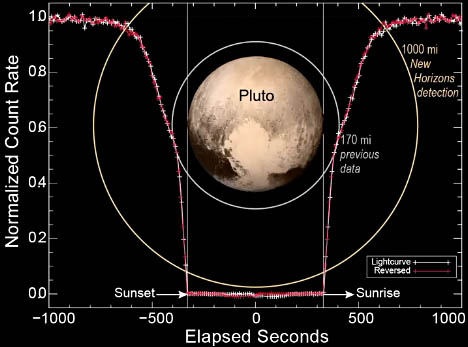New images from NASA's New Horizons spacecraft reveal an ice-covered plain on Pluto that looks remarkably young and fresh.
If, say, six months ago, you'd asked a planetary scientist what the surfaces of Pluto and Charon would look like when seen up close by New Horizons, the likely answer would have been, "Cratered and ancient." The consensus view was that these bodies are too small to have retained much internal heat for 4½ billion years, so they most likely froze throughout early on and have been collecting impact craters on their surfaces ever since.

NASA / JHU-APL / SWRI
But images and other data from New Horizon are telling a very different story. Today, for example, the mission's scientists released an image of a frozen plain that is amazing as much for what it doesn't show (impact craters) as for what it does. According to Jeff Moore (Southwest Research Institute), who heads the scientists assessing geology and geophysics, the utter lack of impacts means this surface can't be more than 100 million years old — a long time by human standards but really just 2% of the solar system's age — and it's likely much younger. "It could be a week old for all we know," he says.
The flat plain corresponds to the western half of the broad, bright, heart-shaped region that's unofficially named Tombaugh Regio. (Seemingly on a naming binge, the team has dubbed this smooth portion of it Sputnik Planum, to honor Earth's first artificial satellite, and the mountains seen in an earlier image Norgay Montes, for the pioneering Nepalese mountaineer who accompanied Edmund Hillary to the summit of Mount Everest in 1953.)
Strange winding depressions flute the surface of Sputnik Planum and carve it into quasi-polygonal sections roughly 20 to 40 miles (30 to 60 km) across. At one end of Sputnik Planum, clusters of knobby hills jut up from these shallow depressions; elsewhere dark material appears to have collected in the troughs.
This craterless plain "has some story to tell," Moore notes, but for now the mission scientists really can't do more than speculate as to what's going on. For example, the grooving could be an expression of convection driven by the cyclic freezing and sublimation of N2 and CO ice just below the surface (akin to a boiling pot of oatmeal), or they could be contraction features analogous to mudcracks on Earth.
To get a sense of the terrain, check out this flyover animation of the plain:
Additional clues have come from Alice, the spacecraft's ultraviolet spectrometer, which shows a concentration of frozen carbon monoxide (CO) in this general area. It's too soon yet to know whether it's relatively pure or just mingled with frozen nitrogen ice on the surface, but principal investigator Alan Stern says no other concentration of CO exists anywhere else on the sunlit portion of Pluto's globe.
Whiff of the Wisps

NASA / JHU-APL / SWRI
In the last two days, the team has gotten its first look at crucial atmospheric data obtained when Pluto passed directly between the spacecraft and the Sun. The resulting occultations -- one on each side of Pluto's disk -- provided a very sensitive probe of the density and structure of Pluto's ultrathin atmosphere. Randy Gladstone (Southwest Research Institute) reported that the nitrogen-dominated atmosphere actually extends out at least 1,000 miles (1,600 km) from Pluto's surface and that it's much the same on both sides of the globe — an indication of stability and lack of wholesale turbulence.
The large radial extent adds to the growing evidence that Pluto is losing what little gas it has at a fairly rapid rate, roughly 500 tons per hour. "We know there's methane in the atmosphere," explains Fran Bagenal (University of Colorado). "It absorbs sunlight, heats up, and gives the gas the energy it needs to escape."
Once in space, explains Fran Bagenal (University of Colorado), the nitrogen molecules are vulnerable: the Sun's ultraviolet radiation, even though 1⁄1,000 weaker than it is here at Earth, ionizes the molecules. Then they're swept up by the high-speed solar wind flowing past Pluto at hundreds of miles per second, creating an ion tail that extends outward, away from the Sun.
Bagenal says the team should have a better estimate of the atmospheric escape rate in August, once all the observations accumulated by the spacecraft's solar-wind and energetic-particle instruments are safely on the ground.
In fact, now that the encounter is largely over, New Horizons is focused on trickling its 50 gigabytes of results back to Earth. By the end of next week, when NASA plans to hold another press briefing, about 5% or 6% of that should be in mission scientists' hands.
 13
13









Comments
Anthony Barreiro
July 17, 2015 at 7:35 pm
Is there any way New Horizons' data could indicate how fast Pluto's surface is changing? I understand that, by comparing New Horizons images to Hubble images, Tombaugh Regio has been there at least since 2006. Pluto's orbit is highly eccentric and different molecules should alternately sublimate into the atmosphere and condense onto the surface as Pluto moves toward and away from the Sun over the course of Pluto's 248 year orbit. Would these processes completely rearrange Pluto's geography every 250 years?
You must be logged in to post a comment.
July 17, 2015 at 9:41 pm
I think we found a fresh planet. A surface that is in the state of upheaval. Constantly changing and gobbling up it's Moons and remaking new ones every 10,000 or so orbits around the Sun. A new Planet, frozen boiling Oatmeal, tital shifts causing faults of land that shrink and pushes up and down mountains and valleys, canyon's erasing the craters' while gases escape the sinkholes of surface ice and energetic winds of atmosphere stripped by Solar wind and gravity between the fulcrum of Moons ever spinning in a wobble, closer and farther away. Are there rings? Yes... Material around it's surfaces and atmosphere move away, producing a ring of atmosphere outside the planet and move into space causing a ring tail away from the Planet.
You must be logged in to post a comment.
July 17, 2015 at 9:45 pm
Pluto: The Solar system's largest Comet.... Possible!
You must be logged in to post a comment.
July 25, 2015 at 8:32 am
I happen to agree here. We are most certainly looking at a very new surface. The problem is we have no way of discussing age of planets based upon impact rate, and sedimentation rates, because we have not idea what they are. Also, those impact, and sedimentation rates may very well be different for different planets, based upon other variables. However, I am inclined to consider it more reasonable that Pluto's surface is far newer than the conservative age of 100 my. After all planet earth has had 4 major extinctions in the last 100my. And, with Pluto's large number of closely orbiting moons, I would say it would be far more reasonable to consider that Pluto's surface is on the order of thousands to hundreds of thousands of years, not millions of year old.
You must be logged in to post a comment.
July 17, 2015 at 9:51 pm
Could the reason for Pluto and Charon "young" surface be the result of a slower form of gravitational tides churning the planets interior similarly to the more vigorous churning of Io by Jupiter?
You must be logged in to post a comment.
Peter Wilson
July 20, 2015 at 1:21 pm
Could be, but because Pluto is so many times smaller than than Jupiter, it is not expected. On the other hand, the frozen carbon monoxide/nitrogen mix may be near its melting point, so counter-intuitive results are certainly plausible.
You must be logged in to post a comment.
Justin S
July 19, 2015 at 3:01 pm
I rather expected Pluto to resemble Dione, the satellite of Saturn; a pock marked non-descript ice-ball. I’m quite amazed by the lack of craters and the varied terrain. I wonder if the “late heavy bombardment” affected only the inner solar system. That might mean that the geography of Pluto is much like what it was after it first formed. I doubt we’ll know in my lifetime.
You must be logged in to post a comment.
Martian-Bachelor
July 21, 2015 at 6:07 pm
I too have always thought it would resemble an escaped moon, though from one of the outer two gas giants (on likelihood arguments).
VVV Earth may h8 Pluto, but Pluto hearts Earth and the whole universe!! (lol)
You must be logged in to post a comment.
Ted-Hauter
July 20, 2015 at 1:38 am
Stunning!
It will be a tough call to return Pluto to planetary status after all the data is studied.
Pluto should make it back to the solar system.
You must be logged in to post a comment.
Anthony Barreiro
July 20, 2015 at 7:46 pm
Pluto has always been in the solar system, and remains so today. As long as Pluto orbits the Sun, Pluto will be a full member in good standing of our solar system. The relatively trivial question of whether Pluto should be classified as a planet or a dwarf planet has no bearing on the fact that Pluto is gravitationally bound to the Sun.
You must be logged in to post a comment.
Corey Rueckheim
July 20, 2015 at 10:03 am
I knew about the frozen plains of Pluto back in 1989, when Kenny Rogers took a ride across the solar system with some interstellar cowboys in the song "Planet Texas." Check out this part of the song:
"I seen London, Paris, Budapest, Kashmir, and Tokyo,
And there ain't no sight like a desert night looking down on Mexico.
To the Moons of Mars and Jupiter, 'round Saturn's rings we rode,
Past the frozen plains of Pluto where even the sunshine's cold,
and MAN I do mean COLD!"
Great song!
You must be logged in to post a comment.
Wayne-Wooten
July 22, 2015 at 3:56 pm
Very interesting to compare the Sputnik plains eruptions to my wife Merry Edenton-Wooten's predictive painting from our planetarium show, "When Worlds Erupt", prepared in 1995 for Pensacola State College's Planetarium. More on it at: http://spaceweathergallery.com/indiv_upload.php?upload_id=115265
including her commentary of how she did the Enceladus and Pluto oil paintings.
You must be logged in to post a comment.
StanR
July 25, 2015 at 1:13 am
I wonder how good the estimates of expected cratering rate (used to determine the "age" of the fresh surface) are. I would expect impacts to be extremely rare. There may be a lot of KBOs, but there is certainly a lot of empty space out there. Relative orbital speeds will be quite slow, meaning that any potential impactor will only very rarely come anywhere near Pluto. In addition, Neptune also may have worked to clear out potential Pluto impactors.
You must be logged in to post a comment.
You must be logged in to post a comment.